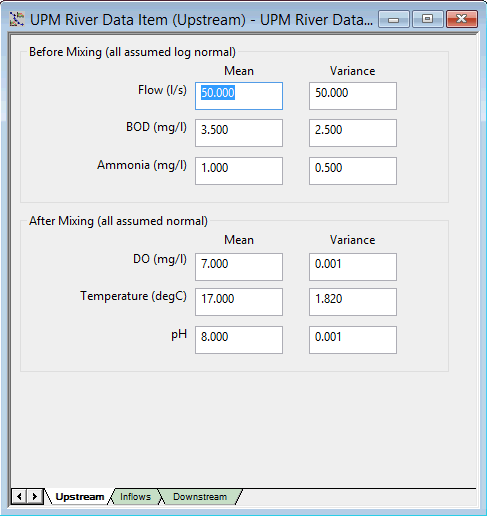UPM River Data - Upstream View
The Upstream tab on the UPM River Data dialog allows you to enter information relating to the river flow immediately upstream of the CSOs (combined sewer outfalls). You must also define certain parameters for the point at which the spills enter the river.
The UPM River Data dialog is displayed when you open an existing UPM river data item by either double-clicking on the item in the model database tree or by right-clicking on it and selecting Open from the context menu.
Before Mixing
The fields in the top section dialog relate to the state of the river immediately upstream of the CSO. If the spill data is for summer events, appropriate summer values should be given. The means and variances are assumed to be from a log normal distribution.
The following fields must be entered:
|
Field |
Description |
|---|---|
| Flow | The mean and variance of the river flow immediately upstream of any spills. |
| Bod | The mean and variance of the BOD concentration immediately upstream of any spills. |
| Ammonia | The mean and variance of the of the total ammonia concentration immediately upstream of any spills. |
After Mixing
The fields in the bottom section of the dialog relate to the state of the river immediately after mixing with the spills from the CSOs. The means and variances are assumed to be from a normal distribution.
The following fields must be entered:
|
Field |
Description |
|---|---|
| DO |
The mean and variance of the dissolved oxygen in the river immediately after mixing with the spills. This is the DO of the plug of contaminated water before any river processes have affected it. For mass balance frequency analysis, this value is used when applying the correction factor for the un-ionised ammonia intermittent standards. For dissolved oxygen impact assessments, this value is used as the initial DO in the plug of contaminated water. |
| Temperature |
The mean and variance of the water temperature in the river immediately after mixing with the spills. Temperature is used to estimate the un-ionised ammonia present for a given amount of total ammonia (see below). Temperature is also used when adjusting various temperature-sensitive rate constants and in the calculation of the DO saturation concentration. |
| pH |
The mean and variance of the pH value for the water column immediately after mixing with the spills. pH is used to estimate the un-ionised ammonia present for a given amount of total ammonia (see below). |
The un-ionised ammonia present for a given amount of total ammonia is calculated using the equation:
|
|
where: x = 10.055 - 0.0324 * T - pHgill T = temperature pHgill estimated pH at gill surface of fish (assumed equal to the pH in the water column) |

